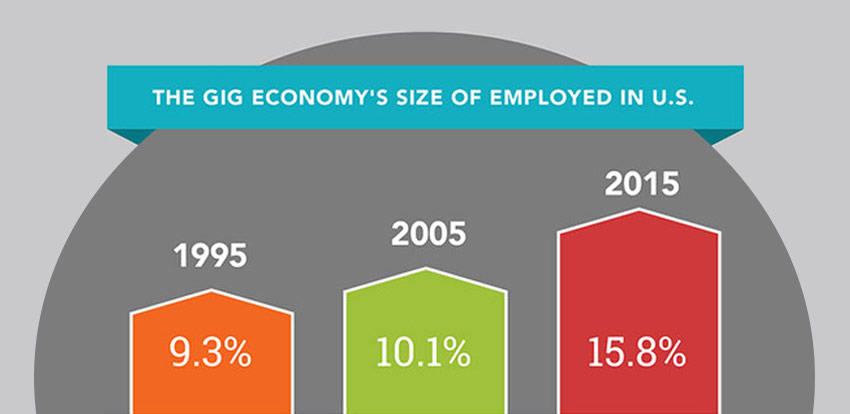
The gig economy has been gathering momentum over the last few years. Titans like Upwork, Fiverr, Behance, and Guru.com are becoming common names associated with opportunity. And, while gigs seem like the perfect way for people to make a little extra cash, HR professionals should be paying attention to the growth it is experiencing.
The gig economy, or alternative work threat, isn’t limited to ‘other people’ in ‘other organizations’ and industries, it’s something your workforce has definitely seen, heard of, and has possibly started dabbling in.
It is a reality that many organizations have to accept as a first step to cashing in on the opportunity it presents.
The lure of the gig economy
Understanding the real value of gigs isn’t easy for many business leaders. For some, the idea that staff would want to spend more time doing more work that isn’t for their organization simply doesn’t add up. It goes against everything they know about flexibility and work/life balance, and how those factors influence today’s workforce.
While there is some truth to these notions, the fact is that employees are applying for more gigs, doing more work, and the value of their efforts is not being recognized by their full-time employers. And if they find that working on gigs is more fulfilling and lucrative than their fulltime jobs, holding onto them will be challenging.
A gig economy for your organization?
But it’s not all doom and gloom. There is a way to get ahead of the threat that gigs pose to your workforce. At vi, we spend a lot of time speaking to HR professionals about staffing issues, new trends, and how the gigs are influencing their businesses.
In most organizations, ad-hoc projects exist where employees are urged to chip in, but often these projects are few and far between and leave other employees out in the cold, wishing they too could have an opportunity to contribute in their own way. What’s more, there is seldom an incentive for employees to step up.
The idea of creating your company’s gig economy shouldn’t feel overwhelming. In fact, today internal gig economies are helping organizations retain staff who would otherwise feel trapped in their roles and decide that leaving the organization is the only way to grow.
For example, IBM’s Blue matching program helped them realize that participating staff are three times more likely to stay put. They’ve seen more staff contribute and move within their organization due to the availability of a program that helped employees realize their potential.
Elements of an effective gig economy solution
The typical gig website allows giggers to bid on new projects and work, giving prospective employers the opportunity to see who the best person for the job is. Employers also have the opportunity of sifting through a database of talent to invite the best of the best to apply for a gig.
It’s not always about the cheapest rate, as more often than not, employers are looking for professionals who are capable of getting the job done right the first time, or those who have a unique insight that can help elevate a business.
vi’s Gig Marketplace is a platform that gives organizations the ability to post new gigs or invite employees to take on projects.
What drives employees to want to participate in an internal gig economy? Research shows us that offering autonomy, purpose, and mastery draw in top talent, and prevent it from searching for rewarding experiences elsewhere.
Creating internal gigs doesn’t stop with just posting an opportunity. With vi you’re able to evaluate projects and track skills development, two important aspects that can make future recruitment simpler.
By creating more gigs and attracting more of your top talent, your organization begins to be seen as a forward-thinking, attractive business that your employees want to be a part of.
Your business starts to realize the value of skills that employees would otherwise not have the opportunity to showcase in their roles but can now apply to internal gigs, and employees begin to feel more valued as they achieve personal milestones without having to leave your organization.
Conclusion
The gig economy can seem like a complex problem that only effects certain industries, but it’s become a reality for many organizations. Understanding that all professionals need an outlet and to be challenged in ways that their current full-time jobs do not offer, and that performing external gigs can be highly lucrative, organizations must turn to creating internal gig economies to keep top talent from leaving to pursue external opportunities.